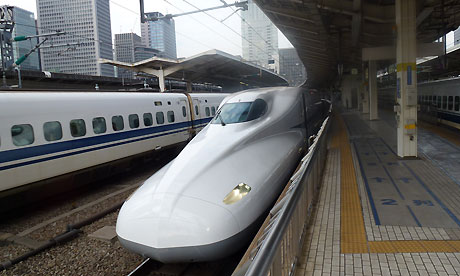
In 1925 Seiji Miita, then general manager of the Hitachi rail factory in Kudamatsu City, travelled to Britain to study "advanced train technology" to take back to Japan.
Nearly 90 years later expertise is flowing in the other direction and his successor, Kentaro Masai, is sending state-of-the-art carriages to the UK instead.
The Kasado facility produces around 400 carriages a year – including the newest iterations of the Shinkansen bullet trains that, from the front, resemble metallic cobra heads and unlike anything else you have seen on the British network.
However, Hitachi has a small niche in our rail market. Nine decades on, Miita's fact-finding mission has helped create one of Japan's newest export footholds in the UK.
A consortium led by Hitachi has been selected by the government to build the sequel to the Intercity 125 fleet – bullet-trains for Betjeman fans – ahead of European rivals including Derby-based Bombardier in a project worth £4.5bn.
Its high-speed trains are already used in the UK, with the class 395 javelin carriages ferrying passengers from St Pancras International in London to Ashford in Kent and beyond, using designs and technology that originated with the bullet train – first built by Hitachi at Kasado in 1963. "The basic structure of the 395 trains is based on that of the Shinkansen," says Masai.
The 395s don't look much like the E5 series bullet trains being built as we tour the factory, but they are evidence that Hitachi has a product, or technological expertise, that can transfer into multiple markets abroad – an exporter's dream.
Hitachi's hopes of building up its UK market share have been dented in the wake of the UK government's decision to select Siemens of Germany ahead of Bombardier's Derby factory for the Thameslink carriage contract, precipitating the loss of more than 1,400 jobs at Britain's last train factory. Ministers have pledged to put UK-based manufacturers on an "equal footing" for the next big contract, for Crossrail, which also features Hitachi on the shortlist.
The 395s were all built on Kasado's production lines but that probably won't wash now following the row over the Thameslink decision, which perhaps explains why questions over the Intercity replacement are directed towards Hitachi's European PRs. The new Intercity prototypes will probably be built in Tokuyama, Masai says, but beyond that nothing has been finalised. Indeed, the contract has yet to be signed following last minute tweaks to the IEP programme by ministers.
There are plans to build a factory in Newton Aycliffe, Durham, to assemble the Intercity trains and one well-informed insider in the UK rail industry says Hitachi is going all-out for the Crossrail contract.
A slide presented at Kasado shows why: by 2015 the majority of train carriage customers will be from outside Japan. Winning Crossrail, in the teeth of clear public and government support for Bombardier, will be a priority.
If that doesn't work, the multiple production lines at Kasado are filled with orders from JR, including Shinkansen and commuter trains that will be used on lines that run through the earthquake, tsunami and nuclear breakdown zones (once conditions allow).
Metres away one such order is being completed, as the shell of a bullet train nears its final fit-out. Masai adds: "We will deliver these according to the original plan, as scheduled."
Despite the quirks of the UK rail market, it is business as usual in Japan.







